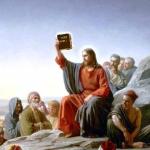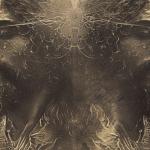by Armondo Collins
Rhetoric Race and Religion Contributor
Throughout history, African-Americans have put the three concepts of God, Jesus, and Black people together in some pretty amazing theological combinations. Oftentimes, this synthesis was achieved by means of folklore tales based on church myth. Black church folklore was both sacred and secular, meaning it was told inside and outside of traditional Christian church settings, by preachers and laity alike. African-Americans used folklore to tell one another stories to about their religion and their relationship to the world (Gilmore, 120-121). One of the goals of this church folk lore was to create a counter-theology, in hopes that new myths could bring the African-American experience closer to the rhetoric of ultimate things (Gilmore, 120-121). This was done in direct response to notions of inferiority pumped into the collective African-American psyche by Whites who sought to divorce blacks from the sight of God and humanity with inferiority myths like “The Curse of Ham”. The idea of a Black God and a Black Jesus, are two examples of counter-folklore myths that seek to refute theories of Black inferiority. They are also good examples of Black Church lore at work. In this case, the work being done by Black folk lore is the creation of alternative visions of reality – a key survival practice African-Americans learned over time as coping strategy.
The Curse of Ham (also called the Curse of Canaan) refers to and Old Testament story in which, Ham’s father, places a curse upon Ham’s son Canaan, after Ham sees his father’s drunken nakedness found in the Book of Genesis (9:20-27). Some Biblical scholars see the “curse of Canaan” story as an early Hebrew rationalization for Israel’s conquest and enslavement of the Canaanites, who were presumed to descend from Canaan. However, the “curse of Ham” has also been used by White Americans and others to justify racism and the enslavement of people of Black African ancestry, whom they believed to be descendants of Ham. This racist theory was widely accepted lore during the 18th-20th centuries, and was responsible for an inferiority complex in many Blacks (121). This last point is evident if one looks at this excerpt on “How We Became Black” from Zora Neal Hurston’s Of Mules and Men.
Long before they got thru makin’ the Atlantic and haulin’ de rocks for de mountains, God was makin’ up de people. Be he didn’t finish em all at one time. Ah’m compelled to say dat some folks is walkin’ round dis town right now ain’t finished yet and never will be.Well, He give out eyes one day. All de nation come up and got they eyes. Then He give out teeth and so on. Then he set a day to give out color. So seven o’clock dat mornin’ everybody was due to git they color except the niggers. So God give everybody they color and they went on off. Then he set there for three hours and one-half and no niggers. It was getting hot and God wanted to git His work done and go set in de cool. So he sent de angels. Rayfield and Gabb’ull to to go ’em so He could ‘tend some mo’ business.
They hunted all over Heben till dey found colored folks. All stretched out sleep on de grass under de tree of. So Rayfield work ’em up and tole ’em God wanted ’em.They all jumped up and run on up to de th’one and they was skeered they might miss sumpin’ they begin to push and shove one ‘nother, bumpin’against all de angels and turnin’ over foot-stools. They even had de th’one all pushed one-sided. So God hollered “Git back! Git back!” And they misunderstood Him and thought He said, “Git black,” and they been ever since. (Mules and Men, 29-30)
The curse of Ham, and other racist Christian church lore, caused many folk within the African-American community to reinterpret the meaning of the stories –and ultimately even religion itself- in their own unique way. One experimenter was A.M.E. Bishop Henry McNeal Turner. His method for circumventing the curse was to “lay it all down at the feet of the Lord.” As a rhetorical trick designed to inspire racial self-pride among African-Americans, he put “Negro-ness” on par with God. This was significant because it started a trend that eventually took Black folk theology, and preaching, way outside the white Christian Church tradition (Young, 141-152). In one sermon, Turner posits a popular folk theology, namely, that God was synonymous with, rather than counter to, Blacks:
We have as much right biblically and otherwise to believe that God is a Negroe, as you…white people have to believe that God is a fine looking, symmetrical and ornamented white man. For the bulk of you and all the fool Negroes of the country believe that God is white-skinned, blue eyed, straight-haired, projected nosed, compressed lipped and finely robed white gentleman, sitting upon a throne somewhere in the heavens. Every race of people who have attempted to describe their God by words, or by paintings, or by carvings, or any other form or figure, have conveyed the idea that the God who made them and shaped their destinies was symbolized in themselves, and why should not the Negro believe that he resembles God…(Wilmore, 125)
Turner’s theology was representative of the coming “New Negro” in the early 20th Century. That he could say what he said publicly, without retribution, is in large part a testament to the agreement of his “Black” church congregation who shared his views.
As time marched on after Turner, and American race relations became more sophisticated, so too did African-American interpretations of their relationship to God, Jesus, and the world. In his book Black Gods of the Metropolis, William Fauset gives a brief history of some of these early 20th Century spiritual movements and their beliefs and practices. One particular history he documents is of interest to this study. That movement is the Moorish Science Temple of America, founded by the Noble Drew Ali.
The Moorish Science Temple is an important stop in the history of the Black Church and its folklore concerning the relationship between African-American humanity and divinity because of its interesting re-articulation of the Jesus narrative. This movement, although non-Christian, took on as its central concern reinventing the ideas of a God and Jesus as a redemptive path for African-Americans. As I said earlier, much of this Black folk theologizing was done in direct response to notions of inferiority pumped into the African-American psyche by Whites. The Moorish Science Temple story shows just how powerful church folklore was in the daily lives of African-Americans–inside and outside of the traditional Christian church (42-47).
Briefly, The Moorish Science Temple was founded in 1913 by Timothy Drew (who later changed his name to the Noble Drew Ali). Drew’s new religion grew out of his dissatisfaction with Christianity and its racially misinterpreted stories, which he viewed as having a stranglehold on African-America. In response to this internal dissatisfaction, Drew created his own collection of “holy scriptures” that combined Christian imagery, eastern philosophy, and conservative moral values into text entitled “The Holy Koran of The Moorish Science Temple of America.” The book aims at improving African-American self-esteem, painting a story of Jesus as a world-traveling African philosopher, who teaches human unity. Apparently, Drew’s idea worked –at least for awhile- because at its height the movement boasted an international membership of some 20,000 and small sects of the movement still exist today (42-47).
Drew told his members that they were no longer Negroes, and never had been. They were “Asiatics” or “Moors”, the displaced descendents of a rich African legacy, which had been stolen by White interlopers. He even gave them membership cards. His members, in turn, viewed their membership as a release from the oppressive racism of the day. Fausset documents that several were arrested for openly refusing to be servile to whites, and even accosted others with their membership cards as proof that White rules held no sway over their life (42-47).
In his article, “Black Nationalism,” J. Herman Blake describes the type of “cultural nationalism” that Drew Ali’s organization is the prototype of. The essential belief of the cultural nationalists was that a scholarly analysis and study of the history of black people throughout the world, particularly in America, would show blacks and whites that Afro-Americans are descended from a proud heritage and have made out- standing contributions to human progress. It was thought that such an understanding would have two consequences: (1) It would give blacks a positive self-image and further the development of racial pride and solidarity; and (2) it would show whites that blacks were no better nor worse than any other race and that because of their contributions, they should be fully accepted into the society…(17)
The Nobel Drew Ali and his Black Moors, however, were not the only Black nationalists re-inventing Christian church lore. Marcus Garvey, well known for his racialized view of religion and history, sponsored a movement much like the Moorish Science Temple, but his organization sought to make “Blackness” not Christianity the universal religion for all his people. Garvey never underestimated the power of religion, particularly Christianity, within the African-American community. He understood the church served as the only arena in which African Americans could begin to exercise control over their lives. Toward this end, Garvey held religion in high esteem, and he worked hard to recruit pastors into his organization. One of those clergymen was George Alexander McGuire, of the AME denomination. Together, they created a brand new black church lore system that included widely distributed artifacts that represented the central characters of their stories. They launched their Black God and Black Jesus campaign under the auspices of the short-lived Universal Negro Improvement Association and the African Orthdox Church (Burkett, 45-68). As David Van Leeuwen recounts:
The UNIA meetings at Liberty Hall in Harlem were rich with religious ritual and language. For even though Garvey rejected McGuire’s effort to transform the UNIA into a black-nationalist Christian denomination, he blended these two traditions in his message. he claimed that African Americans should view God “through our own spectacles” and that “if whites could view God as white, then blacks could view God as black…(2)
In 1924, Garvey, McGuire, and an estimated 200,000 followers, canonized Jesus Christ as a “Black Man of Sorrows” and the Virgin Mary as a “Black Madonna.” Garvey used the images as inspirational tools to help his followers succeed in this life. In his view, African Americans needed to worship a God that understood their plight, understood their suffering, and would help them overcome their present state. Garvey was not interested in promoting hope in the afterlife. Success in this life was the key. Achieving economic, cultural, social, and political success would free African Americans. Unlike traditional Christianity, the afterlife wasn’t his concern (Burkett, 45-68).
Garvey’s took the message of material, social, and political success and transformed it into a religious message. He clearly did not want to challenge the basic doctrines of his followers, so he incorporated them into the whole of his vision. The ideas were apparently enduring because, although Garvey’s organization faltered after his incarceration and deportation, the image of the Black man of Sorrows Jesus is commonly used in today’s Black churches. Similarly, the shrine of the Black Madonna has even showed up as a folklore element in the story the Secret Life of Bees. And, in certain corners of African-American slang, it has become fashionable for two Black men to refer to one another as “god” or “gods”.
The problem with creating the Black God and Jesus has always been that the project collapses in the face of traditional and scientific interpretations of the scriptures. Although the Black God and Jesus folklore is creative, and in a sense tactically sound, racializing and recreating the foundational myths of traditional Christianity is still considered taboo in many African-American religious circles. At the very least, growing popular consensus views the practice as being just as racist as the racism it purports to fight. For this reason, and many others, discussion of the folk roots of the Black God and Jesus concepts have taken onl
y marginal root in mainstream academic discourse. More often than not, the subject is as marginalized as the people who have helped the ideas grow over time.
Akbar, Na’im. Breaking the Chains of Psychological Slavery. Tallahassee:Mind Productions, 1996.
Blake, J. Herman. “Black Nationalism.” Annals of the American Academy of Political and
Social Science. American Academy of Political and Social Science. 382: (Mar., 1969). 15-25.
Burkett, Kenneth. Garveyism as a Religious Movement: the Institutionalization of a Black Civil
Religion. New York: The Scarecrow Press, 1978.
Fauset, Arthur Huff. Black Gods of the Metropolis: Negro Religious Cults of the Urban North.
Genesis 9:20–25
Hurston, Zora Neal. Of Mules and Men.
Van Leeuwen, David. “Marcus Garvey and the Universal Negro Improvement Association.” National Humanities Center. http://nationalhumanitiescenter.org/tserve/twenty/tkeyinfo/garvey.htm
6/22/09.
Wilmore, Gayraud S. Black Religion and Black Radicalism: An Interpretation of the Religious
History of Afro-American People. 2nd ed. New York: Orbis Books, 1990.
Young, Henry. Major Black Religious Leaders: 1755-1940. Nashville: Abington, 1977.
















